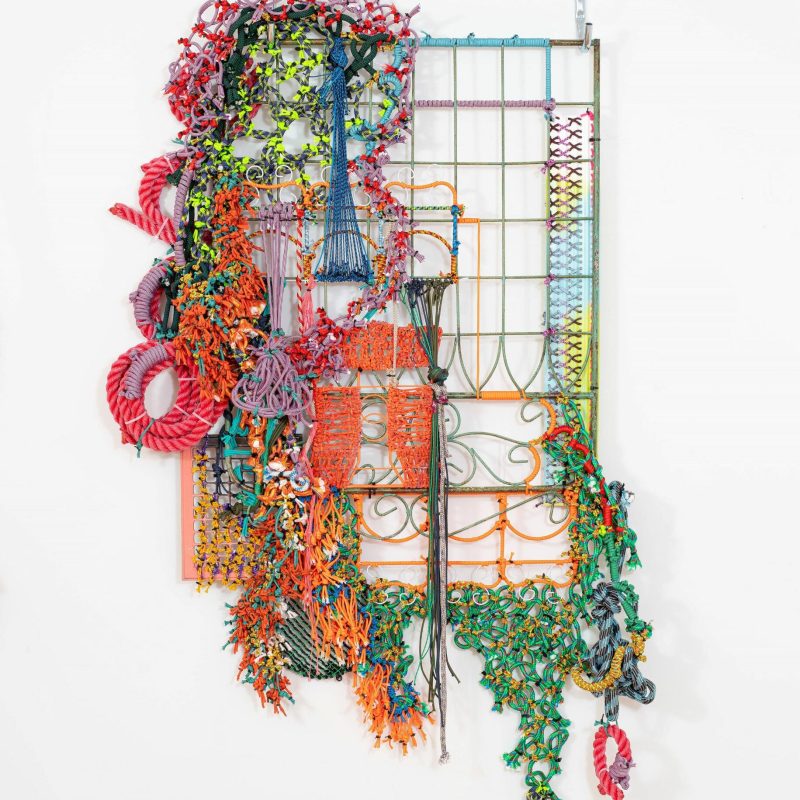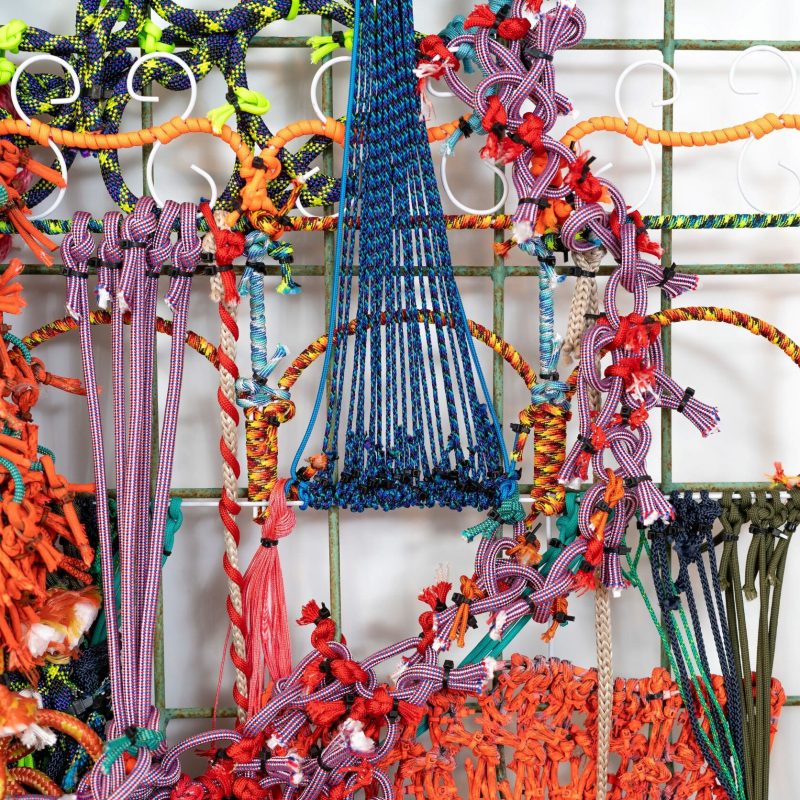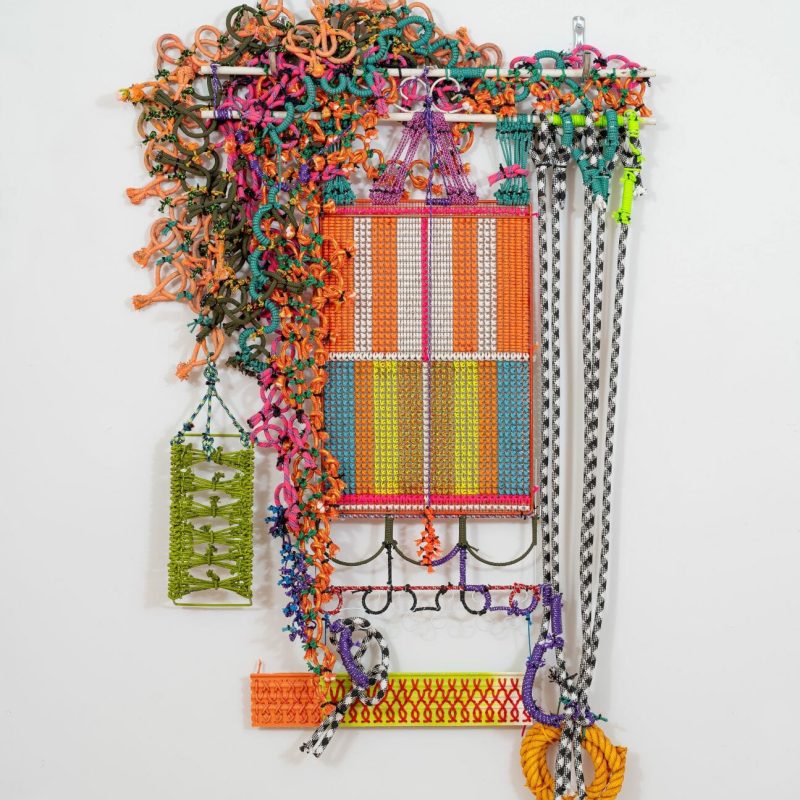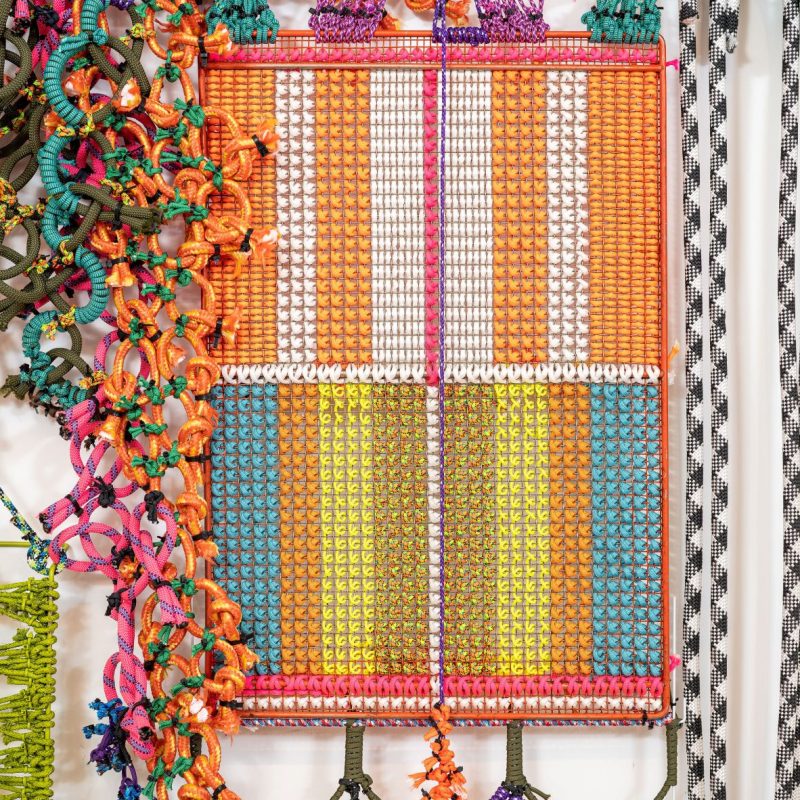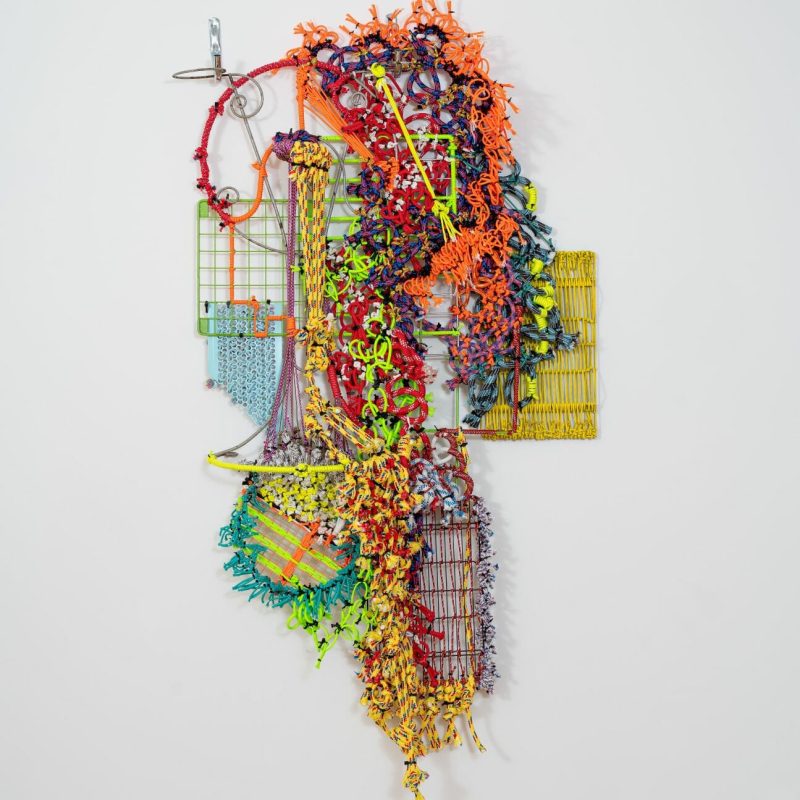LIZ MILLER
*Featured photo: Alchemical Conundrum, assorted rope, fabric, PVC pipe, foam, and other mixed media, dimensions variable, installation view installation view: Spartanburg Art Museum, Spartanburg, SC, 2021. Photo credit: Spartanburg Art Museum, copyright Liz Miller
After her graduation in painting from the Rhode Island School of Design and her MFA in drawing and painting from the Department of Art at the University of Minnesota, Liz Miller began working with textile art and sculpture through a spontaneous approach made up of experimentation and improvisation, creating works that are on the borderline between different disciplines. Her works present conceptual aspects common to both drawing and painting.
The artist has had numerous national and international solo and group exhibitions in which she has shown her work. In addition, she obtained important awards such as the McKnight Foundation Fellowship for Fiber Artists, the McKnight Foundation Fellowship for Visual Artists, and the Joan Mitchell Foundation Painters & Sculptors Grant.
Miller currently lives and works in Good Thunder, MN and is a professor of installation art and drawing at Minnesota State University-Mankato.

When did you approach art and what was your training path?
I’ve been interested in art for as long as I can remember–but it took me a while to find my current path. I pursued undergraduate and graduate degrees in painting, but found myself gravitating towards collage. And although I have no formal training in sculpture or textiles, my work has gradually shifted towards these practices over the last two decades. Everything I understand about sculpture/installation and textiles/fibers is the result of experimentation and improvisation. I am not a great technician in any one area, but by working between disciplinary boundaries, I’ve been able to establish a way of working that feels honest to my own ideas and interests. I’ve also relied heavily on my academic training in painting. Although my work does not look like a typical painting, I still think of it in relation to the disciplines of drawing and painting. Even at its most sculptural, the work always inhabits a space between two and three-dimensionality.

Textile elements and rope alongside pvc pipes, salvaged architectural fragments, fences, plastic materials from various sources. Can you tell us about the concept behind choosing to use mostly materials from our everyday life? Is the material just a medium or does it also become the subject of your sculptures?
The materials in my work are certainly connected to its content—it’s hard to separate form and concept. The mundane materials that comprise my installations and wall-based fiber works are elevated through deliberate acts of care and ornamentation. Improvised weaving, knotting, and other adornment allows simple building materials or pieces of architectural salvage to take on new significance and become part of a new environment in the gallery or on the wall. The armature of my work is in some ways the armature of our contemporary culture. We have built our society on many small, throwaway elements that comprise a kind of overwhelming obsolescence. These elements represent the dreck of American consumer culture—but they also represent personal and collective histories and a larger narrative.

Architectural Hyperbole. Can you tell us about the works that make up this body of work, how the idea came about, and how you are developing it through series work? Why this title?
This group of works was created during my time at Stove Works, an artist residency in Chattanooga, TN, in the summer of 2021. The substrates for the textile components are largely comprised of discarded pieces of ornamental and everyday architecture/building materials/salvaged components found or purchased in Chattanooga.
As I browsed thrift stores for materials, I kept seeing the same remnants in every location: broken plastic and metal shelving units from office and closet organization systems, discarded stove and refrigerators shelves, and so forth. It occurred to me that these small pieces of our lives form a larger architecture, one of obsolescence. I wanted to exaggerate the significance and beauty of these pieces through intricate gestures with rope, cord, and textiles, thereby also creating a duality between hard and soft materials.
In many ways, the works elevate the qualities of the armatures that have been diminished by time and wear—most of the armature materials are themselves mundane, broken, and discarded. Through care and attention, these overlooked yet ubiquitous components of consumer culture gain new significance, strength, and purpose.
Blind and Alchemical Conundrum are an example of your large architectural installations, full of bright and garish colors. What is the significance that color takes on in your research?
I am naturally attracted to bold color. I like to create color combinations that are a bit jarring, a bit discordant, or a bit “too much”. Color can be seductive, but it can also be overwhelming. By pushing the color in my installation environments towards the edge of overwhelming, I am able to alter the mood of the room, to create a feeling of slight un-ease. I guess this is important to me because I see the works as commenting on a kind of overwhelming abundance–I am not looking to create something that is merely decorative. I want to push the limits of how decoration, color, and ornament can function within a given environment. Bright color can be an interesting counterpoint to the balance and symmetry achieved in other aspects of the work.
How important is improvisation in your practice?
Improvisation is essential. I have built much of my career doing temporary, site-specific installations. In these instances, I rely on planning, but also on the spontaneous decision-making that happens on-site. I believe that practice paves the way for improvisation. When creating my installations, I try to practice various choreographies in the studio so that when I get to the exhibition site I am prepared to take risks. This is how I do my best work. Many installation artists work from a detailed plan or diagram. I admire that–but I am not one of those artists! I need chance and improvisation to help me see possibilities I may have overlooked in the initial planning stages.
Does the space transform the art or, in the case of your large installations, is it the art that transforms the space? Or could we say that there is a reciprocal relationship between your works and the space in which they are placed?
I really hope the relationship between the works and the space is reciprocal. The work certainly changes the space it is in…but the space also acts on the work. I think of “site” broadly. Site is about the dimensions of a space, the history of a space, the sense of light in a space, its geography—all of the visible and invisible things that leave a tangible and intangible imprint on the way we experience and understand that space. Even small physical nuances in a space can change the way a work unfolds. For example, in Blind (Fort for 2020) I was given a space with two parts—a low ceiling in one half of the gallery and a much higher ceiling in the other. This allowed the work to unfold in two stanzas. Sometimes the things that make certain spaces challenging are also the things that present exciting possibilities.

How has your work changed during these last two years in which the pandemic has altered our daily lives?
I live in a small rural community and teach at a nearby university. In many ways, my life up to the pandemic had been so hectic that I had not adequately explored the rural landscape where I live–despite having been here for over 15 years! During the pandemic, my husband and I spent quite a bit of time riding our bikes on the gravel roads surrounding our town. On these excursions, I found architectural fragments such as discarded pieces of fences and gutter guards that had been blown into ditches and were strewn across roads. These elements then started to find their way into my work.
The pandemic was also an opportunity for me to slow down and concentrate on discreet wall-based works (such as the Architectural Hyperbole series) instead of focusing so heavily on installations. Although I still traveled a bit to do large-scale installations, the majority of the past two years for me, like many people, has been spent at home. Because installations were not taking me away from the studio, I was able to think about the kind of wall-based works I wanted to embark on, and to start making those a reality.
What is the source of your inspiration today? What are you working on?
I’m currently working on a series of wall-based textile works that integrate more complex salvaged armatures—specifically, the headboards from beds that end up in thrift stores. I’ve become very interested in how the objects that form the armatures for my installations can be somewhat biographical—the headboard from the bed that someone slept on for years, which ends up in a second-hand store, is now the primary component of a work. The forms are beautiful, but there is also a richness to the objects on a conceptual level—an acknowledgement that these “throwaway” items once belonged to someone, and that history is embedded in these items. In the coming year I am hoping to collect similar objects directly from my community and to create new works centered around these objects.



